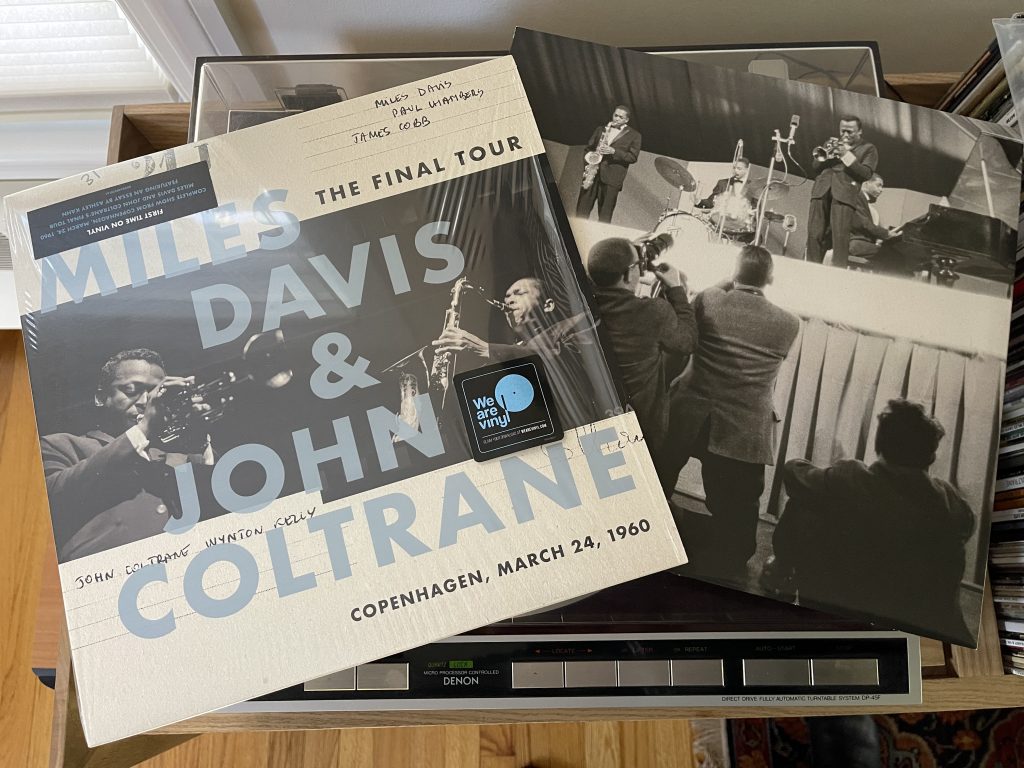
Album of the Week, April 23, 2022.
As Robert Frost wrote (and S.E. Hinton quoted), nothing gold can stay. This was certainly true of John Coltrane’s sojourn in Miles Davis’ band.
As we’ve seen, Trane had already left Davis’ employ once, to get clean of his heroin habit, after which he rebuilt his career performing in Thelonious Monk’s band before rejoining Miles. The second and final departure happened for a different reason: Trane developed into a star. He had signed with Atlantic Records in 1958, and in April 1959, a month after the first recording session for Kind of Blue, he entered Atlantic Studio in New York City to begin laying down the tracks that would eventually emerge on his debut for the label, Giant Steps. The sessions for the album would continue throughout the year, during which he also recorded material for Coltrane Jazz. These albums, featuring only his compositions, helped him build his fan base further. But he continued to record and perform with Miles during this period, even going on a European tour with him.
This helps to explain the first track of this record, which captures one of the concerts released as The Final Tour: The Bootleg Series, Vol. 6. Jazz impresario Norman Granz introduces the players, getting applause for each name, until he introduces Coltrane… and the crowd goes nuts, applauding at least as loudly as they do for Miles.
The performances heard on this record are a hybrid between the style of Miles’ first great quintet (Cannonball Adderley had left the group by now) and Coltrane’s solo materials. Not quite a year after the recording of Kind of Blue, that album’s opening track, “So What,” had picked up the tempo considerably, going from the gentle stroll heard on the album to something considerably faster and darker. The track would keep the faster arrangement from this point forward. And Trane seems to have been let off the leash.
Indeed, as Ted Mills has pointed out, sometimes it doesn’t even seem like the two greats are playing in the same band. With Miles soloing, the band sounds like a fired-up version of the group that made Kind of Blue almost a year previously, but they’re still recognizable as the same group. When Trane steps up, however, the band catches fire.
Trane was just beginning to move beyond the chord-focused explorations that drove his Prestige recordings into explorations of spiritual verities, and you hear some of these directions in his playing in the Copenhagen concert. While there is no overblowing or squalling in the horn, sounds that would come to define the outer reaches of his Pentecostal exploration of the world around him, some of the other trademarks of the classic Coltrane sound are there: the abandonment of cool, the breaking beyond the boundaries of the eight bar chorus, the use of modal scales as a vehicle for spiritual exploration, and of course, the cascading “sheets of sound” in which it becomes difficult to hear the individual notes of his runs as they search out beyond the boundaries of the improvisation for something new.
On its surface, “On Green Dolphin Street” would seem like a strange vehicle for Trane’s search. The song, by Bronisław Kaper with lyrics by Ned Washington, was an MGM movie theme in 1947 and then mostly forgotten until Miles’ sextet resurrected it in a recording in 1958, in their first recording sessions. Their recordings, which were followed by versions by Bill Evans’ trio, Wynton Kelly, and Eric Dolphy, established the song as a jazz standard. But you don’t hear the standard improvisation when Coltrane solos. You hear him taking flight.
After this tour, Trane would return to the studio with Miles’ group once more, for two songs. But he was otherwise off on his own flights of exploration. We’ll hear more from both Miles and Trane soon.
The vinyl version of The Last Tour is an odd artifact; it presents material from one of the European performances of the tour and splits “On Green Dolphin Street” across two sides of the record. A fuller record of the tour can be found on The Bootleg Series Vol. 6: Miles Davis & John Coltrane, The Final Tour, which in addition to the Copenhagen show also presents performances from L’Olympia in Paris and the Konserthuset in Stockholm. I’ve provided links to the performances on the LP below; enjoy!

Postscript: the final performance of “So What” on the full Bootleg Series recording makes clear what had happened by this time in the tour. Trane’s conception of the chord series for “So What” was slowly but surely morphing into an entirely different composition, one that he would record many times live: “Impressions.” Indeed, if all you hear of this “So What” is Trane’s solo, it’s virtually indistinguishable from “Impressions.”
I can’t believe I’ve been listening to these albums for almost 30 years and just now heard this. Sigh.